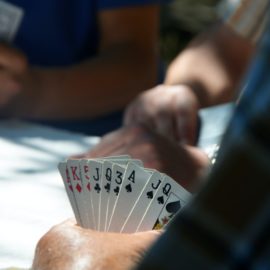
What’s Britney Spears’s book The Woman in Me about? How did Spears break free of her conservatorship from her father?
Britney Spears has been a pop music icon since she was a teenager. In The Woman in Me, Spears details the ups and downs of her career and private life, from the joy she’s found to the trauma she’s endured.
Read below for a brief overview of The Woman in Me, Britney Spears’s book on freeing herself from her trauma and struggles.
The Woman in Me by Britney Spears
Since she debuted her first hit song at the age of 16, Britney Spears has been a pop icon of the 21st century and one of the best-selling musicians of all time. She’s won many music industry accolades, including several MTV Music Video Awards, Teen Choice Awards, and a Grammy for Best Dance Recording. Millions of fans have attended her concerts, both when she was on tour and during her landmark five-year Las Vegas residency, which grossed over $100 million.
However, behind the scenes of her achievements, Spears lived a life of family turmoil, emotional trauma, and never-ending scrutiny in the public eye. She struggled through relationships, breakups, and motherhood under the lens of a media industry that seemed determined to paint her in the worst possible light. As she bent under the strain of that pressure while also suffering from perinatal depression, her father trapped her in a conservatorship that robbed her of her autonomy while exploiting her fame for others’ financial gain.
The Woman in Me, Britney Spears’s book published in 2023, is a memoir of her public career and private life, from the joy she’s found in her artistry and her children to the trauma she’s endured at the hands of her family and the music business. Given that so many other people have shaped and controlled Spears’s public image throughout her life, Spears uses this autobiography to reclaim her narrative and put her point of view on the public record.
In this article, we’ll follow the story of Spears’s life from her small-town childhood and early successes to her struggles with stardom and finally, to the 13-year conservatorship that severely restricted her control of her life and that she had to fight in court to escape. We’ll also highlight the general struggles Spears has had to endure, such as the misogyny prevalent in the entertainment business, the generational trauma and abuse that held her captive, and her fight to rediscover and reclaim her sense of worth after being exploited for most of her life.
The Autobiography of Britney Spears
Spears’s life story includes sadness and success, but despite the depth of her darkest moments, Spears insists the bad times don’t diminish the excitement and happiness she’s found through her music and in raising her children. In this section of the guide, we’ll follow Spears through several periods of change in her life—her journey from child performer to teen pop idol, the heyday of her initial success, the media backlash and family troubles that followed, the years of her conservatorship when her father had absolute power over her life, and her fight to take that power back.
From Childhood to Stardom (1981-1998)
Spears was born on December 12, 1981, to parents whose marriage was already rough due to her father’s drinking. Spears writes that ever since she can remember, music was an escape from her problems at home, and singing was the only way she could safely express herself. Spears discusses how her singing and dance career began, her early appearances on TV while trying to live a normal life at home, and the break that led to her first hit single and her sudden rise to international fame.
Music was the bright spot in Spears’s life, and when she was eight years old, she auditioned for a reboot of The Mickey Mouse Club. Though Spears didn’t win a part on the show, the head of casting recommended an agent in New York, who agreed to represent her.
Living in the Limelight (1999-2003)
The tremendous success at the start of her career swept Spears into a world she could have never imagined and kicked off a period of creativity and excitement. Between recording albums and going on tour, a host of new opportunities arose, such as commercials, acting roles, and even a spot in the 2001 Super Bowl halftime show. With the income from her music, she was able to provide for her family, building the house that her mother always wanted and digging her father out of his business debts.
This period of her life also brought difficulties, however. In 1999, Spears toured with her childhood co-star Timberlake, who’d become a member of the pop group NSYNC, and became romantically involved with him. The couple lived together in Orlando, Florida, and though their relationship wasn’t spotless, Spears felt so strongly for Timberlake that she overlooked his various affairs. Spears states that she only cheated on him once and that she told him about it so they could move on. When Spears became pregnant with their child, Timberlake pushed her to have an abortion, insisting that they were too young to be parents. To keep her pregnancy and abortion secret, Spears didn’t go to a doctor, but took pills to force a painful miscarriage.
Spears writes that left to herself, she wouldn’t have ended her pregnancy, but she did so for Timberlake’s sake. Nevertheless, he ended their relationship in 2002, breaking up with her via text message while she was filming a music video. Timberlake would go on to write a solo album painting Spears as a horrible girlfriend who broke his heart.
Turmoil and Unwanted Attention (2003-2007)
Spears details the media backlash that followed her breakup with Timberlake, her marriage to aspiring rapper Kevin Federline, and the fallout from their messy divorce. The media was sympathetic to Timberlake as he promoted his take on his relationship with Spears, but it wasn’t supportive of her side of the story.
Spears became involved with a former backup dancer, Kevin Federline, who Spears says treated her with a tenderness that had been missing in her life. She didn’t learn until after they were dating that he had children from a prior relationship. Nevertheless, she married Federline in 2004 and tried to restore some normalcy to her life by taking a break from recording and touring. Three months later, she was pregnant again, and the paparazzi became even more persistent.
Stolen Years (2008-2015)
On February 1, 2008, the California court placed Spears in a conservatorship on the grounds that she was incompetent to make her own decisions. Spears’s father—an alcoholic who was teetering on bankruptcy—was granted control of Spears’s personal life and her entire financial estate. Spears was forced to accept a court-appointed attorney and was given no chance to defend herself. During this, her mother stayed silent and complicit; after all, the whole family depended on Spears for their income. Spears’s father made it clear, in no uncertain terms, that she would do whatever he said without question.
The Fight of Her Life (2016-2021)
For Spears to win back control of her life would require more courage than anything she’d done. Her years chafing under the conservatorship had strengthened her in ways she hadn’t been before, but challenging her father’s authority would result in a retaliation that would almost prove unbearable. Spears talks about how she began to assert herself, how her father responded by sending her to rehab on trumped-up allegations of mental instability, and how she finally found the legal help she needed to end her father’s abuse of his power.
On June 22, 2021, Spears called the police to report that she was being abused. On the following day, Spears made a statement to the court that was broadcast online for all to hear. In it, she described the conditions she’d lived under and her prior efforts to end her conservatorship. In September 2021, the court stripped Spears’s father of control of her life. In November, the conservatorship ended completely, and Spears received the news that after 13 years, she was a free woman again.
Spears Highlights Universal Issues
Spears isn’t alone in having suffered the many problems she’s faced throughout her life, but her celebrity status has both amplified those struggles and given her a platform from which to address them. In The Woman in Me, Spears uses her life experiences to shine a light on issues of dysfunctional families, the misogyny prevalent in society in general—and the entertainment industry in particular—as well as the difficulties people face when trying to control the narrative of their lives in the face of other people’s expectations.
Generational Trauma and Abuse
The first major issue to shape Spears’s life was a toxic family pattern. Family dysfunction is a widespread epidemic that usually takes place behind closed doors. In recounting her story, Spears lays bare many unhealthy traits of broken families, including abuse that persists through generations, parents who force their children into adult situations, and the secret-keeping behavior that prevents any issues from being addressed.
It’s a sad truth that many people who were abused as children repeat that behavior when they become adults. Spears tells the story of her paternal grandfather, who had his wife committed to an asylum and who forced his son—Spears’s father—to practice sports far beyond the point of exhaustion, demanding high performance and controlling his life. As an adult, Spears’s father adopted all these behaviors, driving Spears to perform at the cost of her mental and physical health, then locking her away when she rebelled to assert his control of his family.
It was Spears’s mother who pushed her into professional work while she was still developing as a child. When Spears was very young, her mom would also take her drinking on trips to the Gulf Coast where they’d both have alcoholic daiquiris. As money from Spears’s TV and music work came in, and as her parents’ jobs failed to pay the bills, teenage Britney was thrust into the role of family breadwinner with the full knowledge that everyone else was now dependent on her. Nevertheless, Spears recounts that any time a stressful situation arose within her family, she felt like she regressed to a younger age, especially when her parents exerted their control.
None of Spears’s family problems were ever seen by others. Spears writes that when she was a child, her mother put on a happy, welcoming face for all of Spears’s friends from school, making their house the cool place to hang out. Spears felt she always had to be “a nice person” and keep her actual feelings secret, which she learned in part from her mother’s people-pleasing behavior and partly from her upbringing in the American South, where being polite at all times is highly valued. The secret-keeping in Spears’s family reached an extreme during the conservatorship, when her father used the threat of exposing Spears’s alleged substance abuse and mental health problems as a means of exerting control.
Misogyny in the Entertainment Business
Another problem Spears ran into during her career is an underlying problem in society as a whole. Misogyny can be found along any career path, but in show business, its power is shown in stark relief. Spears discusses how the media puts an excessive focus on women’s bodies, how male artists demonize women to advance themselves, and how male performers are allowed to act in ways for which women are often condemned.
Spears recalls that from the start of her career, she noticed that the interview questions she received were heavily focused on her appearance, while her male contemporaries were asked about other topics. Spears was often criticized for appearing too sexy while also being chastised for any blemish in her looks. During and after her pregnancy, the press hounded her about whether she’d regain her youthful beauty. All through her life, Spears says that others have treated her body as something they had a right to criticize and control.
Putting women down isn’t restricted to the press. Spears writes that she experienced this when Timberlake used a distorted depiction of their romance to increase publicity for his new album, boosting his image by tarnishing hers. Timberlake never mentioned his cheating on Spears, and neither did Federline when he painted Spears as an unfit wife and mother while promoting his debut album. Tellingly, the press didn’t interrogate the men in Spears’s life about their failings as it often does to women in the same situation.
In general, Spears points out that male performers in the entertainment business are held to a lower standard than women. Even worse, men’s bad behavior is often celebrated as part of the “sex, drugs, and rock ‘n roll” lifestyle. Male artists are rarely, if ever, shamed for lewd behavior, drug use, and wild parties—rather, for them such things are status symbols. Further, while some male artists have paid a price for their behavior, none have had their personal freedoms taken away as Spears’s were for anything short of outright criminal actions.
Reclaiming the Narrative
Familial and societal expectations often make it difficult for people to be their true, authentic selves. Celebrities like Spears find this especially true when the demands and expectations for what they say and do can be far greater than what others experience. Spears describes how her public persona has been shaped by others for so many years, and why it’s been so vitally important for her to find her own voice and take control of her story.
Spears acknowledges that the world that fame offers is just an illusion and that she’s one of those who didn’t handle it well. Many times in her life, she gave into pressure to keep touring, performing, and putting on a brave face when she should have slowed down to take care of herself. She often let other people tell her story in a way that served them instead of her, whether that was her family and friends, the entertainment press, or her own PR team. Every time someone else cashed in on her fame, they added to the fake “Britney Spears” persona that was all the public knew and that Spears herself sometimes came to believe.
After escaping from her conservatorship, Spears says that reclaiming her narrative and finding her own voice were essential to healing the wounds of her past, as well as taking charge of her future. As a child, she expressed her authenticity through music—a form of communication where the words didn’t matter as much as the emotion they conveyed. She also believes that her wild and rebellious years during the height of her stardom were important to testing her limits and finding out who she was.
Now that Spears is once again in control of her life and decisions, she says she needs time to nourish the woman inside her while tending to the pain that the child in her has suffered. She’s recorded one new song—“Hold Me Closer”—which helped her regain her artistic voice. Aside from that, Spears won’t immediately go back to making music, but is instead taking time to heal and be herself. In the meanwhile, Spears expresses gratitude to God, to her fans, and to everyone who supports her for being able to experience the fullness of life.






